
Ancient Egyptial Hieroglyph
Cat: LAN
Pub:2023
#2305b
Sou Miyakawa (宮川創), Jiro Kondoh (近藤二郎), JSesh Software, et al.
23530u
Index

a------A----b----d-----D----g-----h---H--i---k-----K-----l---m---M-----n--o-O-p--q--r--s--S----t----T----w--W--x-----X---y--z
god
index
; ; Amun; Aten; Anubis; Isis; Khonsu; Nut; Osiris; Sebek; Thoth; Uraeus=Cobra god;
Index2
; ankh; box=hen; cobra=iart; ear=mesedjer; eat=wenem; eye=iret; fish=remu; flame=akheet; fly=afef; forehead=dehenet; gods=netjer; goose=geb; grape=irep; head=tep; hear=sedjem; Hejet; heka-magic; hen=box; heru=sun; horn=ab; house=per; injury=webenu; make=iri; magic=heka; moon=iaf; ox=neg; papyrus roll=medjat; road=wat; room=at; sail=nai;see=degi; ship=depet; storm=djaw; sweat-fedet; think about=neka; Wadjet; water=mw; Wedjet; wind=tjaw; woman=zet=set;
Re:
- Etymology of hieroglyph: <G. hierós =sacred +glýphō =engrave, meaning 'sacred carving'.
- Egyptian hieroglyphic script contains 24 uniliterals, much like in English.; there ae aso biiteral and triliteral signs.
- Excellent OSS software: JSesh
- 1799 仏Jean F. ChampollionがRosetta Stoneに描かれたEgyptian Hieroglyphs, Demotic, Greekの碑文などからHieroglyphsを解読した。
- Egyptian hieroglyphsは、基本的にアブジャド(abjad)文字、即ち、子音のみの音素文字(segment script)である。
- Color: Gods (red), Pharaoh (green), Symbol (purple)
Gods
; Aten; Amen (Amun); Anubis; Four sons of Horus; Geb; Horus; Isis; Khonsu; Nun; Nut; Osiris; Ra; Shu; Thoths;
>Top <Hieroglyph>
- Ancient Egyptians called the hieroglyphs 'the words of Gods'. It was established with the Creation to make the order of things through the experience. Therefore, words were thought to have infinite power not only to classify categories of things, but also to embody them.
- Ancient Egyptian language, now a dead language, is close to those of North Africa (Berber and Chadic) and West Asia (Arabic and Hebrew).
- During Christian ear in Egypt, the influx of Greek language increased in addition to Coptic (in the period c325 -c800 AD).
- Egyptian have not present, past, or future tenses, but have verbal aspects (imperfect and perfect phrases), which depends on whether the action is ongoing or completed.
- Reference: Hieroglyph vs. Arabic [>right table]
- The history of writing method is considered roughly contemporaneous with Sumerian cuneiform. Hieroglyphs only express consonants, while cuneiform represents syllabic units including vowels.
- Both scripts share the same grammatical mark placed at the end of a sentence indicating the meaning as well as the break of the sentence.
- Hieroglyphics have no longer used since 4C AD, largely due to the religious reasons; Egyptian traditional religion was idolatrous and unrelated to Christianity. On the other hand, Coptic script replaced hieroglyphs, inducing additional six characters from Greek.
- Hieroglyphs (which literally means sacred carving characters) had been used for inscriptions on tomb murals and stone monuments, while faster writing type (called hieratic) was used for other purposes including accounts and various daily records.
- In ancient Egypt, only a handful (about 1%) could read and write hieroglyph; scribes could become high-class civil servants. Most scribes learned cursive hieratic, not hieroglyphics, and later demotic to keep account, record, or substitute writing.
- From 26th dynasty onward, new Demotic scripts were used.
- Leather and papyrus were most commonly used to write the Hieratic. Papyrus was used in scrolls. However, papyrus is an organic material, which could not be preserved well; most of the papyrus records have been found in desert burial sites.
- In 296, the last hieroglyphic inscription was wrought when Roman Emperor Diocletian, expressing eradication of Christianity. The last engraved hieroglyph was in 294 in the temple on the island of Philae.
- Later, with the protection of Christianity, hieroglyph was regarded as pagan writing and was baned; the Egyptian language adopted Greek alphabet instead (Coptic script).
- Furthermore, even Coptic alphabet was no longer used due to Egypt's conversion to Islam; its connection to the past was completely disconnected.
- In Europe in renaissance period, Egypt was considered a dangerous world under Ottoman rule and European interest in Egypt was lost.
- Since late 16C, European interest recovered among collectors and others of Egyptian relics.
- In 1718, Louis ⅩⅤ of France dispatched a survey of ancient Egypt and discovered ancient Thebes.
- In 1753, the British Museum was founded; which increased interest in collecting ancient Egypt relics.
- In 1791 it is symbolic that Mozart composed Magic Flute, which appears a scene of praising Osiris and Isis deity.
- In 1797, Napoleon dispatched military and academic expedition, including about 170 scholars accompanied.
- However, in 1801, the French army was defeated by the allied forces of UK and Ottoman Empires, and lost its interests in Cairo and Alexandria, and withdrew. However the accompanied large scientific team produced accurate maps and record and brought many documents back to France.
- In 1802, Vivant Donon published his "Travels in Upper Egypt", by which Egyptology was established.
- In 1820s-30s: After the Napoleonic War in 1815, various research and collection were continued in Thebes, Memphis and Abydos, etc; which were transported to Europe in large numbers.
- History of Hieroglyphic Decipherment:
- In 1419, Hieroglyphica was published, the understanding was incorrect; which regarded hieroglyphs as pictographs.
- In mid 17C, Athanasius Kircher, a German Jesuit priest, called a late Renaissance man, pointed out that Coptic could be the final state of the Egyptian language.
- In 1762, the cartouche (oval enclosure of hieroglyph) was mentioned as a way of emphasis the names of kings and gods.
- In 1799 the discovery of the Rosetta Stone (Pierre de Rosette, 115cm long, and weighs 760kg) :
Pierre Pouchard, an officer in the French Expeditionary Force, found a stone tablet in the town of Rachid (called Rosetta) written tree types of languages; Hieroglyphs, Demotic and Greek letters
engraved on the granodiorite. The tables is inscribed (understood by Greek description) with the achievements and edicts of Ptolemy V, such as his victory over the large rebellion in southern Nubia. In the last sentence which engraved, "the same is recorded in the sacred, national, and Greek scripts."
- In 1802, the Rosetta Stone was sent to the British Museum as a trophy of General Mouneux's surrender to the British army on 1801/9/8. But until then, both Britain and France made copied of the inscription and sent it to major institutes around Europe. (thanks to the international cooperation maintained between European countries despite the period of war.
- In 1819, Thomas Young, a British physicist who advocated the wave theory of light, acknowledge that the hieroglyphic writing system consisted of phonetic and ideographic characters. However, he insisted that hieroglyphs have phonetic values only when representing foreign names such as Ptolemy or Cleopatra.
- In 1822, Jean-François Shampollion of France, getting introduction of hieroglyph from mathematician Jean Fourier, then elucidated that the phonetic expression could be applicable to all hieroglyphs, not just foreign names. Shampollion's strength was his proficiency in various languages including Coptic, Hebrew, Sanskrit, Greek, Arabic, Persian, etc.; and he studied intensively many Egyptian documents. In 1832 he published his 'Outline of the Hieroglyphic System', which explained not only the script method but also its grammar mechanism.
- 1828-30: Champollion visited Egypt and succeeded to read many paintings and inscriptions for the first time in more than a thousand years.
- After Champollion's sudden death in 1832 at the age of 41 , his work was succeeded by German Carl Richard Lepsius, who elucidated that hieroglyphs had not only one but also two or three phonetic characters.
ヒエログリフ
- ヒログリフは'神の言葉'と呼んでいた。天地創造で確立され、人々の経験によって事物の秩序を具象化するのが文字であるとした。即ち、言葉には存在の範疇を分類するだけでなく具象化する無限の力があると考えられた。
- 古代エジプト語は、現在は死語だが、北アフリカ (ベルベル語、チャド語)と西アジア (アラビア語・ヘブライ語) の言語に近い。
- エジプト語は、古エジプト語 (古王朝時代)、中エジプト語 (中王国時代)、新エジプト語(新王朝時代と第3中間期)、デモティック(末期〜ローマ支配時代、コプト語 (キリスト教時代)に分からえる。中エジプト語が語尾変化するのに対し新エジプト語以降は言語単位を連結する。
- キリスト教時代には、コプト語(325-800AD頃)に加えて、ギリシア語からの流入が増加。
- エジプト語の時制は、現在・過去・未来ではなく、その行為が継続中か完了したかによるアスペクト (不完了相と完了相)。
-
English
Hieroglyph
Arabic
die
mwt
مت mt
count
Hsb
حصاع hasae
digit
Db
اصبع asbae
good
nfr
خيل khail
water
mu
ملء ma
- 文字の歴史は、シュメールの楔形文字とほぼ同時期。ヒエログリフは子音表示だけだが、楔形文字は母音を含む音節単位を表す。
- 語の末尾に置かれる限定符は、意味と次の語との切れ目を表すのも、楔形文字と共通。
- 4C ADにはヒエログリフが使用されなくなったのは、キリスト教と無縁の偶像崇拝的といいう宗教的な理由が大きい。ギリシア語から6文字を追加したコプト文字が利用された。
- ヒエログリフは、Hieroglyph: <G. hieros=sacred +gluphe=carvingの通り、石碑の碑文に利用され、それ以外の会計や手紙には、速く書ける筆記体 (神官書体, hieratic)が使われた。Hieraticには、2つ以上の書体を組み合わせた合字が作られた。
- 古代エジプトでは読み書きできるものがほんの一握り(約1%)であった、字が書ける書記は公務員になれた。但し、大半の書記は、ヒエログリフではなく筆記体のヒエラティック、その後はデモティックを覚えて、帳簿や記録、代筆などを行った。
- 第26王朝以降、新たなDemotic文字が使われた。
- Hieraticを書くのに、最も利用されたのは革とパピルスである。パピルスは巻物として利用。但し、有機物であるパピルスの保存性はよくないので、現存するパピルスの大半は、砂漠の埋葬地で発見されたものである。
- 最後のヒエログリフ碑文は、296年のディオクレティアヌス皇帝のキリスト教根絶の碑文である。最後には、394年にフィラエ島の神殿に刻印されたのが最後。
- その後、キリスト教の保護にともない異教徒の文字は禁止され、エジプト語もギリシアアルファベットが採用された。(コプト文字)。
- さらに、エジプトがイスラム教に改宗したことによって、コプト文字も使われなくなり、過去とのつながりは断絶してしまった。
- ルネサンス期の欧州にとって、エジプトは、オスマン帝国の支配下にある危険な世界と考えられ、欧州の関心はますますなくなった。
- 16C後半から、エジプト遺物も収集家などと関心を集めた。
- 1718年、仏ルイ15世による古代エジプト調査によりテーベを発見。
- 1753年に大英博物館が創設され、そのコレクションとしてエジプトへの関心が増大。
- 1791モーツアルトの魔笛には、オシリスとイシスを讃える場面が登場する。
- 1797年ナポレオンによる学術・軍事遠征。学者170人ほどをが同行した。
- 但し、1801年にフランス軍は、英国・オスマン帝国連合軍に敗退し、カイロとアレキサンドリアを失い、撤退した。但し、大規模な学術チームを同行させ、正確な地図と記録を作成し、書類を仏へ持ち帰った。
- 1802年ヴィヴァン・ドノンが "上エジプト旅行記"を出版し、エジプト学が成立した。
- 1820-20年代: 1815年のナポレトン戦争後、テーベ、メンフィス、アビュドスなどでさまざまな遺物の記録収集が行われ、大量に欧州に運ばれた。
- ヒエログリフ解読の歴史:
- 1419: ヒエログリフィカ出版 (内容の理解は不完全)ヒエログリフを絵文字とみなした。
- 17C半ば、遅れてきたルネサンス人と言われるイエズス会の独神父Athanasius Kircher が、コプト語がエジプト語の最終段階であることを指摘した。
- 1762年カルトゥーシュ(楕円形の囲み)が王や神の名前を目立たたせるためのものと指摘。
- 1799年ロゼッタ石 (高さ115cm, 重量760kg)の発見:
仏遠征軍の将校ピエール・プシャールは、ラシード (ロゼッタ) の町で、花崗閃緑岩にヒエログリフ、デモティック、ギリシア文字の3種が刻印された石板を発見。この石板は、プトレマイオス5世の英字プト南部での大反乱を治めたなどの業績と勅令を刻んだもの。最後の一文には"同じ内容が、聖なる文字、国字、そしてギリシア語で記録"とあった。
- 1801/9/8のムヌー将軍が英国軍に降伏したことの戦利品として、1802年に大英博物館に送られた。但し、英仏双方は碑文の写しを、欧州各地の主要な研究所に送付した。(欧州各国が戦争中の中の国際協力は評価できる。)
- 1819: 英国物理学者の光の波動説を唱えたThomas Youngは、ヒエログリフの表記体系は、表音文字と表語文字であることを発見した。但し、音価をもつことはプトレマイオスやクレオパトラなどマケドニア人の名前を表すときに限るとした。
- 1822: 仏のJean-François Shampollion は、数学者のJean Frourierにヒエログリフを紹介され、研究に没頭し、外国人の名前だけでなく、すべてのヒエログリフに適用できることを解明した。シャンポリオンは、コプト語・ヘブライ語・サンスクリット語・アラビア語・ペルシア語など多様な言語に習熟して、多くのエジプト文献を研究した。1832には、ヒエログリフ体系概論を出版し、文字だけでなく、文法も解説した。
- 1828-30: シャンポリオンはエジプト訪問し、多くの絵画や碑文の情報が千数百年ぶりに読むことができた。
- 1832のシャンポリオンが41歳で急死後、独のカール・リヒャルト・レプシウスが継承し、ヒエログリフには1音のみならず、2音、3音の表音文字があることを解明した。
>Top <Tutankhamun>:
- c1342-1323 BC, Pharaoh of late 18th Dynasty. ascended to the throne at nine until nineteen, restored traditional polytheistic from Atenism, and shifted the court from Amarna, moved back to Thebes. His father was Akhenaten, and mother was referred as his aunt. His wife is Ankhesenamun, half-sister. Newferneferuaten (Akhenaten's wife Nefertiti or his daughter Meritaten) have become co-regent shortly before Akhenaten's death and reigned for some time after it.
- Tutankhamun's mother was his aunt 'the younger lady'. Tutankhamun reburied his father's remains in the Valley of the Kings. He had bone necrosis and a possible clubfoot, including scoliosis and strains of malaria.
- In 1922, British Egyptologist Howard Carter excavated Tutankhamun's intact tomb. There ware 5,398 items in the tomb, including a solid gold coffin, face mask, thrones, archery bows, trumpets, food, wine, sandals and linen underwear. etc. A dagger had an iron blade made from a meteorite.
- Then country was economically weak and in turmoil, and diplomatic relations with other kingdoms had been neglected. Tutankhamun sought to restore them, in particular with Mitanni. Actually he had advisers including Ay and General Horemheb (Ay's possible son in law) The successor Harmhab eventually erased the names of Akhenaten, Nefertiti, Tutankhamun and Ay.
- In his their regnal year Tutankhamun reversed his father's reign; ended the worship of Aten god and restored Amun god to supremacy. The city of Akhetaten was abandoned.
- The pharaoh who in life was one of the least esteemed has become in death the most renowned.
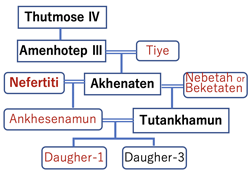

- c1342-1323 BC ツタンカーメン王 9歳で即位、19歳で没。伝統的にアテン信仰へ復帰し、首都をアルマナからテーベに戻す。父はアクエンアテン、母はかれの叔母でもある。妻は異母姉のアンケセナーメン。アクエンアテンの妃であるネフェルティのその娘のメリトアテンが摂政であり、ファラオーの死後もしばらく統治した。
- ツタンカーメンの母は、若い淑女を言われている。ツタンカーメンは父の遺骸を王家の谷に埋葬し直した。ツタンカーメンは、骨の壊死、湾曲した足や脊柱側弯やマラリアの後遺症に悩まされた。
- 1922に英国のエジプト学者ハワード・カーターが手つかずのツタンカーメンの墳墓を発掘し、5,398品の遺品を発見した。その中には、黄金の棺、黄金のマスク、冠、弓矢、トランペット、食料、ワイン、サンダル、亜麻の下着などが含まれている。また隕石から作った鉄の刃の短剣が見つかっている。
- 当時のエジプトは経済的な困難と混乱の時期であり、周辺諸国との外交関係も途絶えおり、彼はそれら、特にミタンニ国との関係を修復しようとした。実際には、宰相のアイと将軍ホムエムヘブが采配した。なお、ホムエムヘブは王位簒奪後、アクエンアテン以降4代の王の存在を抹殺した。
- ツタンカーメンは、父親のアテン信仰を止め、アメンを最高神としてカイクし、アケンアテンの都は放棄した。
- ツタンカーメンは生存中は最も軽視されたが、死後は最も著名なファラオとなった。
Various information of Ancient Egypt:
- Population:
- It is estimated that 2M in the Old Kingdom, 2.5M in the Middle Kingdom, and 4M around AD zero. The upper limit of the population is calculated 4.5M according to the population density per arable land. Other estimate shows that the number of villages is around 18,000, with total population is about 7M.
- Alexandria was the largest city in the world, probably with a population of 500K.
- A population study written on a papyrus estimates that the infant mortality is 33% and average life expectancy is 24 years.
- Population estimates in ancient times ranged from 100-250 persons per hectare of the historic site area. However population density tends to increase as time passed. Also population can be estimated from the number of special buildings like religious facilities.
- Land:
- arable land basin with a few kilometer bandwidth located along the Niles; called 'Kemet" (black land), while Desheret (red land) in desert areas.
- All lands belongs to Pharaoh, and all crops are once delivered to storage of the temple, then the surplus after tax collection is distributed.
- Seasons:
- Flood Season called 'Akhet': four months (July - Nov.) worked for Pyramid construction and flood control.
- Sowing Period called 'Peret': four months (Nov - Mar) worked for cultivation and seed sowing
- Harvesting Period called 'Shemu': four months (Mar-July) worked for harvesting.
- 1 year = 120 days times 3 =360 days
- Occupation:
- mostly Farmers
- Scribe: from children of aristocrats and others. Training schools for scribe available.
- Craftsmen: miners, metallurgists, metalworkers, Masons, Potters, Carpenters, and various artisans.
- Women: bakers, cleaners, hairdressers, servants, and dancers.
- Slaves: only war slaves
- Scale of miners: dispatched mining expeditions with 10K men.
- Soldiers: professional soldiers in the later period. Others were conscripts.
- Study:
- Astronomy and mathematics to predict the Nile flood
- Distribution of agricultural land: land area surveying, geometry
- Recording: Hieroglyphics (sacred inscriptions), and Hieratic (priestly script) wrote on papyrus paper:
- Entertainment:
- banquets (held by the upper class), music, meals, storytelling, dancing (particular for Sed Festival)
- archery, horsemanship, hunting, fishing, wrestling
- indoor board games, Senet games (like chess)
- Food:
- staple food: wheat (flat-bread), barley (beer)
- vegetables: onions, garlic, lettuce, grapes, dates, figs, pomegranates, beans, chickpeas
- from foreign origin: apples, plums, olives, watermelons, melons, peaches, pears; wine was also produced for the upper class.
- meat: mainly for the upper classes. pigs meat used for food oil, and chickens (since the New Kingdom), and other small animals like wild birds, fish, etc.
- mostly healthy diet with little animal fat; twice a day - breakfast and dinner. Drinks are milk. Beer is a soup-like drink.
- Lifestyle:
- Men: mostly farming, sometimes involved for pyramid construction and flood control works during off-seasons.
- Women: mostly housework (baking bread) and childcare
- Marriage: husband and wife are basically equal. Dowry is wife's own property. Divorce possible by agreement. Remarriage is possible after bereavement.
- Clothing: linen made from flax; men wear shenti (white loin cloth), women wear a tubular dress. Cotton was imported since the New Kingdom for the upper class. Footwear is papyrus made sandals.
- Hairstyle: men with cropped hair; women with bobbed hair. The upper class wear wigs.
- Makeup: vegetable oils is a must for protection from the strong sunshine. Sesame oil used for the upper class, while castor oil for the commoners. Egyptian reddish-brown skin differentiated them from dark-brown or yellowish brown neighboring foreigners. The noble ladies used eyeliner, white powder, rouge and nail polish (made from loose strife grass and oil). Malachite powder used for eyeshadow. Pierced earrings.
- Leisure: board games.
- Standard scales:
- 1 cubit (=distance from elbow to the tip of middle finger =43-52 cm (cubitum means elbow) = 2 spans (span = from tip of thumb to the tip of little finger)
- 1 span (22 cm) = 3 palms (palm = from forefinger to little finger of a grip)
- 1 palm (8 cm) = 4 digits (digit = width of a finger 2cm)
- View of life & death: Essential to human existence.
- Ka: spiritual being. usually represented as two arms raised above (=kA), meaning to receive offerings to sustain life force.
- Ba: depicted as human-headed bird figure, symbolizing the spiritual part. Ba could leave the body of the dead and fly freely.
- Akh: the form of the dead to spend life in the underworld. Bar and Ka merge to form Akh, becoming an eternal and immortal being.
- Shwt: Shadow of a person as another important element, protecting the person from harm.
- Rn: a name of the person as an important element. Without such a name, the person could not be an official human being.
- Lessons: The maxims of Ptahhotep (The first copy was written in the Old Kingdom. It matched the social and intellectual thinking of that time period. The papyrus dated in 12th dynasty is considered as the original source. )
- Injustice exists in abundance, but evil can never succeed in the long run.
- He who listens becomes the master of what is profitable.
- God loves him who listens. He hates those who do no listen.
- A perfect word is hidden more deeply than precious stones. It is to be found near the servants working at the mill-stone.
- Only speak when you have something worth saying.
- May you heart never be vain because of what you know. Take counsel from the ignorant as well as the wise.
古代エジプトいろいろ:
- 人口:
- 古王国時代200万人、中王国時代250万人、新王国時代300万人、紀元元年頃400万人。耕地面積当りの人口密度による罫線では450万人が上限とのこと。によると、町村の数は18,000で、人口700万人という。
- アレキサンドリアは世界最大の都市で人口50万人としている。
- パピルスによる人口調査では、乳児死亡率33%、平均余命24年と推定されている。
- 古代における人口推計は、遺跡面積1 ha当り100-250人程度。人口密度は時代が下がるにつれて過密化。また都市の中の神殿など宗教施設の数からも人口推定が可能。
- 土地:
- ナイル川流域数kmの恩恵を受ける農地: ケメト(黒い大地), 砂漠地帯はデシェレト (赤い大地)
- 土地はすべてファラオ。農作物は一旦神殿に納入した後、徴税後の余剰分を分配
- 季節:
- 増水期アケト 7月〜11月 (4ヶ月): 建設、治水工事
- 種蒔期ペレト11月〜3月 (4ヶ月): 耕作、種蒔
- 収穫期シェムウ 3〜7月 (4ヶ月): 収穫
- 1年=120日✕3
- 職業:
- ほとんど農業
- 書記: 貴族の子弟ほか。養成学校あり
- 職人: 採掘、冶金、金属加工、石工、陶工、大工、職工
- 女性: パン焼き、掃除婦、美容師、召使い、踊り子
- 奴隷: 戦争奴隷のみ
- 鉱夫: 採鉱遠征隊(1万人規模)
- 軍人: 時代後期には職業軍人。ほかは徴兵
- 学問:
- ナイル川氾濫予測: 天文学、数学
- 農地分配: 測量術、幾何学
- 記録:ヒエログリフ (聖刻文字)、ヒエラティック (神官文字)、パピルスの神
- 娯楽:
- 宴会 (上流階級)、音楽、食事、語り、踊り(セド祭)
- 弓術、馬術、狩り、魚釣り、レスリング
- 室内ボードゲーム、セネトゲーム(チェス)
- 食料:
- 主食の小麦 (平たいパン)、大麦 (ビール)
- 野菜は、たまねぎ、にんにく、レタス、ブドウ、ナツメヤシ、いちじく、ザクロ、ソラマメ、ヒヨコマメ
- 外国から伝来の食料: リンゴ、プラム、オリーブ、スイカ、メロン、モモ、ナシ; ワインも製作していた (貴重品)
- 肉類: 主に上流階級用。豚 (食物用油)、鶏は新王国以来;その他、小動物、野鳥、魚など
- 食事は朝夕2回で、動物性脂肪ほとんどない健康食。飲み物はミルク。ビールはスープ的な飲み物。
- 生活:
- 男性: 農業中心、農閑期は、ピラミッド建設や治水工事
- 女性: 家事 (パン作り)と育児
- 結婚: 夫婦は台東。持参金は妻の固有財産。合意により離婚可能。死別すれば再婚も可能。
- 衣服: 亜麻から作ったリネン (麻布)男はシェンティ (白い腰布)、女は筒型ワンピース。新王国時代から木綿を輸入 (上流階級用)。履物はパピルス製のサンダル。
- 髪型: 男は刈り上げ、女はオカッパ頭。上流階級はカツラ
- 化粧: 強い日差し対策としての植物油は必須。上流階級はゴマ脂、庶民はヒマシ油。赤銅色の肌は、黒褐色や黄褐色の近隣民族との差別化。貴婦人は、アイライン、白粉、紅やマニキュア (ミソハギ科の草と油脂で作った)。孔雀石の粉のアイシャドー 。イヤリング(ピアスも)
- 余暇: ボードゲーム
- 度量衡:
- 長さ: 1 cubit (43-52cm) (cubitum=肘)=7 palm =1 digit
- スパン: 手を広げた時の親指〜小指(22 cm)
- パーム(掌尺): 手のひら (8cm)
- ディジット: 指の幅 (2cm)
- 死生観: 人間の存在に欠かせないもの
- kA: 霊的存在。上に挙げて両腕として表現される。供物を受け取り生命力を維持する。
- ba: 人頭の鳥の姿。精神部分を象徴。バーは、死者の肉体を離れ自由に飛び回れた。
- akh: 死者が冥界で過ごすときの姿。バーとカーとが合体としてアクとなり永遠不滅の存在となる。
- shwt: 影の存在も人の重要な要素。人を危害から守る役割
- rn: 名前であり重要な要素。名前がなければ人として正式な存在にならない。
- 教訓物語: プタハへテプの教訓 (古王朝時代から)
- 悪事は沢山存在するが、悪事は決して長期的には成功しない。
- 耳を傾けるものは、利益の長者となれる。
- 神は聴く者を愛するが、聴かない者は愛さない。
- 完璧な言葉は、宝石よりも探し出すのがむずかしいが、石臼を使う召使いの所でみつかるものだ。
- 言う価値がある場合だけ、口を開け。
- 知ることは心にとって無駄にはならない。賢者と同様に愚者にも相談すべきである。
Chronology:
- 700-250K years ago: Paleolithic age; hunters and gathers distributed in eastern and western deserts.
- c250-50K years ago: Homo Sapiens; Neanderthal unidentified.
- c35-30K years ago: graves of Homo Sapiens discovered with stone axes buried.
- c21-17K years ago: Wadi Kupanya site.
- c13-12K years ago: East Africa became wetter, causing rise of the Nile river (Kadan culture):
- burial of traumatized human, and burial of cattle bones.
- c9K years ago: Naqada & Playa site; Neolithic age with cultivation and domestication started.
- megalithic culture used for calendar circle
- c6K years ago: started settle life along the Nile river basin with farming and herding.
- c5.5-4.5K years ago: Fayoum & Omari culture at the Middle Egypt;
- found the grains of six-row barley, emmer wheat, flax grain; also bones of sheep, goat, pig and cattle. (wheat, sheep and goat originated in west Asia)
- c5.5K years ago: Merimedean culture; the oldest settlement in Egypt; crouched burial with few burial accessories, meaning no social differenced among the dead.
- Pre-Dynastic Period: the early state was found in only 1000 years.
- c4K years ago: Amur period (=Naqada Ⅰ); the Naqada culture is an important prehistoric culture in Upper Egypt.
- c3.6K years ago: Gerzey period (=Naqada Ⅱ):
- the population increase; larger cemeteries of decorated tombs, wooden and ceramic coffins, and the bodies wrapped in flax cloth; reflected with hierarchical society.
- Marl earthenware (high-density pottery containing calcareous material), painted reddish brown with red ocher, painted ships found; potter's wheel production; also for ceremonial pallets were made; flint knives found; made by the specialized artisan groups.
- Copper or Bronze Age started; copper casting techniques began.
- c3000-2686BC: Early Dynastic Period: 初期王朝時代 (第1-2王朝)
- 3150-3100BC: Narmer, 1st Dynasty, the first ruler of Upper & Lower Egypt
- 2686-2181: Old Kingdom: 古王国時代 (第3-6王朝)
- 2613- 2494: 第4王朝: Golden age (2600-2500BC);
- King Sneferu's bent pyramid
- Giza pyramid & Great Sphinx: Khufu, Khafre, Menkaure
- 2181-2055: First Intermediate Period: 第1中間時代(第7-11王朝)
- 2055-1650: Middle Kingdom: 中王国時代 (第11-14王朝)
- 1650-1550: Second Intermediate Period: 第2中間時代 (第15-17王朝)
- 1550-1069: New Kingdom: 新王国時代(第18-20王朝)
- 1479-1458BC: Hatshepsut, regent then queen of young ThutmosⅢ
- 1362-1336BC: Akhenaten & 1370-1330 BC Nefertiti
- 1341-1323BC: Tutankhamun
- 1069-664: Third Intermediate Period: 第3中間時代(第21-25王朝)
- 664-332: later Period of Ancient Egypt: 末期王朝時代(第26-31王朝)
- 356-323BC: Alexandros Ⅲ
- 69-30BC: Cleopatra Ⅶ
- 30BC-395AD: controled by the Roman Empire: ローマ帝国支配時代
歴史区分
- 約70万年 -25万年前 : 旧石器時代: 狩猟・採集生活: 東西砂漠に分布
- 約25万年 -5万年前: ホモ・サピエンス; ネアンデルタールは未確認
- c35千-30千年前: ホモ・サピエンスの墓; 石斧が副葬
- c21 -17千年前: ワディ・クッパーニャ遺跡
- c13 -12千年前: 東アフリカの湿潤化、ナイル川増水 (カダン文化)
- 外傷の埋葬人骨・埋葬牛
- c9年年前: ナカダ・プラヤ遺跡; 新石器化; 栽培と家畜化
- 巨石文化カレンダー・サークル
- c6千年前 - ナイル川流域での農耕牧畜での定着生活
- c5.5-4.5千年前: ファイユーム・オマリ文化; 中エジプト
- 六条大麦、エンマー小麦、亜麻の粒を発見; 羊・ヤギ・豚・牛の骨
(麦・羊・ヤギは西アジア起源)
- c5.5千年前: メリムデ文化: エジプト最古の定住集落; 屈葬で副葬品はほとんどなすい; 死者の社会的差異なし
- 先王朝時代 (わずか1000年の間に初期国家の誕生)
- c4.4千年前: バダリ期; 副葬品から富の分化
- c4千年前: アムラー期(=ナカダⅠ期)
ナカダ文化は上エジプトの重要な先史文化
- c3.6千年前: ゲルゼー期(=ナカダⅡ期)
- 人口増大、墓地の大型化、階層社会化、装飾された墓、木棺・陶棺、遺体を亜麻布で包む
- マール土器(石灰質を含む高密度土器)、ベンガラで赤褐色に彩色、船の絵を描いた; 轆轤製作; 儀式用パレット; フリント製ナイフ; 専門職人集団
- 銅〜青銅器時代; 銅製品の鋳造技法;
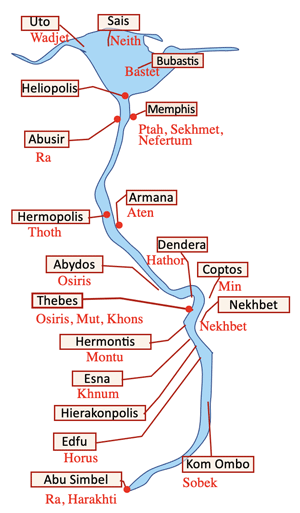
- Hieroglyphs can be used in three ways:
- Phonetic, representing a sound
- Determinative, clarifying meaning
- Ideogram, picture representing a concept
- We could know how to read hieroglyphic inscriptions going back 5,000 years ago through Coptic language, indigenous language of Egypt survived until today; just like the relationship between Latin and Italian.
- In 1822, Jean-François Champollion could read the cartouche of some late Egyptian rulers like Alexander, Cleopatra, and Ptolemy. The more decipherment took off in the 1820s, the discovery of the Rosetta Stone (discovered in 1799 by the French Army). Ramses Ⅱ, the great
Hieroglyph
Pronunciation
Remarks
>Top <A>:












<A>:
- [A]/G1 =ع; vulture; aleph; also
Horus, son of Osiris; enemy of God Seth; depicted as a hawk or as a man with the head of hawk; God of sky.; worshipped throughout Egypt.
- [i-t:n:N5] >Aten God; was depicted with small ankhs at the end of its rays which extended down to the royal family. ; the Ankh also symbolized the purifying power of water.
- [anx][(anx-]/S34 >an(e)kh; アンク; 三子音文字; 生命の意 (=エジプト十字) <meaning of 'life' <Womb; Many gods are depicted bearing an Ankh to represent their vivacity and immortality.
- [anx-dd-wAs:nb]: Ankh was often linked with Djed (representing stability) and Was (representing strength) to form a powerful amulet.
- [G25-x:t] >akhet, アケト
 [G25-x*t:N18], akhet=horizen
[G25-x*t:N18], akhet=horizen [G25-x:t-Q7], akheet=flame, 炎
[G25-x:t-Q7], akheet=flame, 炎 [G25-X:t-I13], Uraeus=Cobra god
[G25-X:t-I13], Uraeus=Cobra god [G25-x:t-D6], 神の目
[G25-x:t-D6], 神の目 [G25-x*t:Y1], 良いもの; Papyrusの巻物
[G25-x*t:Y1], 良いもの; Papyrusの巻物
- [a-b-F16] ab, horn, 角
- [i-n-p-w-E16] >Anubis God; Jackal): anepu アヌビス(Anubis)神; ミイラ作りの神: Jackals were often seen on the edge of the desert, where Egyptians were buried. It was believed that the jackals guarded the souls of the dead.; Ancient Egypt too more human form; cosmological deities and gods of warfare and hunting followed.
- [S28] >folded cloth with fringe
- [i-mn:n-R4:t*p]; 第18王朝Amenhetep Ⅳ: ツタンカーメンの父親の宗教改革前の名前。Akhenatenに改名
- 14C BC: 新王国 Akhenaten of the Amarna period.
- [<-i-(t:n:ra)-Ax-x:n->] Akhenaten "Effective for the Aten"; built the new capital Akhentaten (=horizon of the Aten), halfway between Thebes and Memphis.
- [a-b-db] ab, horn, 角
- [a:f:f-L3] afef, fly, 蝿
- Aten God:
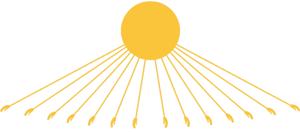
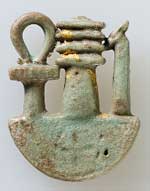

Horus
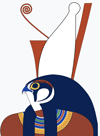
AmenhetepⅣ
→Akhenaten
14C BC:

Anubis
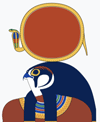
>Top <B>:

<B>:
- [G53] >Ba; "Ba" is the physical essence after death; Ba would fly away from the deceased person's tomb every morning and would fly back to the tomb for the night.
- [O40-O40\] >Benben stones, 尊厳の石 →Pyramid; rising of life
<B>:
>Top <C>:









<C>:
- [V10], cartouche (cartridge); divine protection; protection against evil spirits in this life and afterlife; ouroboros serpent biting its own tail
- [<-(i*i)-f-V4-l->] caltouche symbol
- [W18] > canoptic jars; containers to hold internal organs of a dead person, as Egyptians needed all internal organs after death in the afterlife.
1) [i-m-s-t-A40] Imseti with human-head representing South to preserve liver, 2) [N14-G14-t:f-A40] Duanatef with a jackal-head representing East
for stomach, 3) [(Aa5-Q3)-i-i-A40] Hapi with baboon head representing North for lungs, and 4) [q-b-H-M30-n:n:n-M12*M12*M12-f-A40] Qebensenuf with falcon head representing West for intestines.
- [S38-S45] >crook & frail; were 2 emblems of god Osiris, then became to symbolize the authority of pharaohs. Pharaoh is also represented as the shepherd of his people as the flail symbolizing the provider of food to the people.
- [<-q-l-i-wA-p-A-d-r-A->] Cleopatra Ⅶ (69-30BC)
- Four sons of Horus:
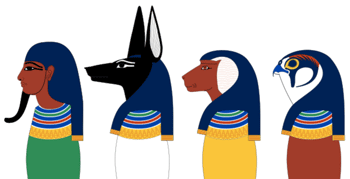
>Top <D>:









<D>:
- [R11] >Djed; represented a cedar tree w its branches removed, w four parallel bars.; giving its name to the city of Djedu (Lower Egypt); backbone of Osiris; As a hieroglyph, it represents stability, durability, and rebirth and regeneration; There was an annual festival during the month of Koiak which cenlebraed the murder of Osiris by Set, and the later resurrection of Osiris, by raising the Djed on the last festival day.
- [(anx-dd-wAs):nb] Ankh-Djed and Was
- [d:h-n:t-tp] > dehenet, 額
- [d:g-ir] >degi=see,見る
- [D:n-H-H5] >djeneh, 翼
- [d:O39:r-t-N]/-S3 Deshret (=Pschent Crown), Red Crown of Lower Egypt; when combined with Hedjet (White Crown of Upper Egypt, it forms Pschent (Double Crown), called sekhemti.
- [d:p*t-P1] depet= ship, 船
- [n:a-P1] nai, sail, 航行する
- [D:a-w-P5] djaw= storm, 嵐
- [d:h-n:t-D1] dehenet =forehead, 額
<D>:
- Ankh, Djed and Was:

>Top <E>:












<E>: Egyptian Math
- [Z1] >一、bar
- [V20]>十、かかとの骨、trap
- [V1]> 百、rope
- [M12] >千、lotus
- [D50] >万、bent finger
- [I8/I7] >十万、tadpole or frog <Heget-God
- [C11] >百万、Hef/Huf-God
- [V9] >千万、circle on bar
- [D10] >Eye of Horus; protect against envy, disease, harmful animals, evil spirits, and royal power
- [D10\] (right) Eye of Ra; symbol of sun; personification of goddesses
- [N] en =for, 〜のために
- [M] em =in, の中において
<E>:
- [Z1*Z1*Z1:(Z1*Z1)]=5

- [V20*V20:V20]=30

- [V1*V1*V1:(V1*V1)]=500

- [D50*D50*D50:(D50*D50)] =50,000

>Top <F>:



<F>:
- [H6] >Feather of Maat; Maat Goddess's feather represents 'ensuring justice.; because one's heart would be weighted against the Maat Feather; if the heart was found equal or lighter than this, he was a virtuous person and would go to Aaru (=paradise). If not, then his heart would be eaten by Ammit, and would be cursed to remain in the Underworld forever.
- [f:d:t-mw] fedet=sweat, 汗
- [N-Z3-nTr-spAt:spAt:spAt-M:zH:Hb-Z3-tp:Z1-tr-ra:Z2A]
=N nTr spAt M Hb tp tr
for the sake of gods of Nomos, at the festival of beginning of the season
<F>:
>Top <G>:


<G>:
- [g]/W11 <jar-stand
- [g-b-gb] >geb, goose, ガチョウ
<G>:
- Gardiner Sign List: G38など
>Top <H>:






<H>:
- [h:e-w-hrw-Z1]; heru, sun, 日
- [r:a-ra] ra=sun
- [T3-t-S1] > Hedjet, White Crown of pharaonic Upper Egypt.
- It combined with Deshret (Red Crown of Lower Egypt) to form Pschent.
- [h:n-Q5] hen= box, 箱
- [H-k-A-Y1v] heka=magic, 魔法
- [<-i-mn:n-Xnm-(t-HAt)-t-Spsi->] 1507-1458BC, Hatshepsut, Royal wife of ThutmoseⅡ; second queen to have ruled Egypt; her name was erase of official monuments 20 years after her death.
- [zH:Hb] heb =festival
Hatshepstu:
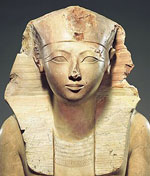
>Top < I >:









< I >:
- [i-t:n:N5] >Aten; 太陽光線の神; Amenhetep ⅣがIkhnatonに改名し elAmana時代を築く。后はNefertiti
- [i-mn:n-C12] >Amen (Amun) God; 中王国Thebe都以来、Ra神と習合したAmen-Ra神として最高神となった。GreekやCopticではAmunと呼ぶ。Theban Triad (Amun, Mut, Khonsu)
- [i-ii-m-Htp]/M17-M18-G17-R4 >Amenhetep
- [ir]/D4 >iri=make, do, 作る, する
- [ir:t*Z1] >iret=eye, 目
- [Q1-t:H8-B1] >Isis God; wife of Osiris, and mother of Horus; made the first mummy from the dismembered parts of Osiris; the giver of life; helps the dead enter the afterlife; Osiris and Isis were the most widely worshiped deities.
- [i-r:p-M43] irep=grape
- [i-a-H-iaH] iaf=moon
- [i-a:r-t-I12] iart =cobra, uraeus
Amen (Amun): Creator God, patron deity of Thebes.
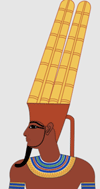
Isis God,
wife of Osiris
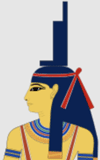
>Top <J>:
<J>:
<J>:
>Top <K>:




<K>:
- [x:n-sw-w] >khensu (or Khonsu); 月の神コンス (テーベ三柱神Amun, Mut, Khonsuの一人)
- [<-x-w-f-w->] >Khwfw: Khufu-King
- [kA]/D28 >Ka (=consort); the life given to the person when they're born - a spiritual essence during life.; "." is the physical essence after death
- [V39] >Knot of Isis; similar to the ankh, symbol of life; also called Blood of Isis, representing menstrual blood of Isis and the magical powers it gave.
Khonsu: Moon God
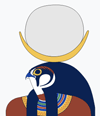
>Top <L>:

<L>:
- [M9-M10] > Lotus symbol; represents rebirth; unification of two Egyptian kingdoms; lotus was included in perfumes in ancient Egypt; heal infections
<L>:
>Top <M>:
- ʼ





<M>:
- [mw] mu, water
- [mA:mAa-a:t-C10] Maat god;
- [z:A2-Z1] Man
- [ms-s-Dr:r-DrD] mesedjer=ear, 耳
- [m-DA-t:mDAt] medjat=papyrus roll, パピルスの巻物
Maat God
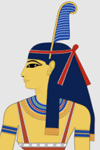
>Top <N>:











 or
or 



<N>:
- [nb] /V30 >[nfr]/F35 > beautiful, good, perfect; sometimes written 'nfr+f+r' to clarify the spelling of preceding triliteral hieroglyph.
- [nw] >nu
- [nw*t:N1]>Nut God; ヌト、ヌウト; 天空の女神; .tは女性形
- [nTr]/R8 > netjer=gods, 男神
- [nTr-nTr]/R8-R8 >netjeruwi, 男神(双数形); reduplication 重複
- [nTr-nTr-nTr]/R8-R8-R8 >netjeruw, 男神(複数形)
- [nTr-r:t-B1] >netjeret=goddess, 女神
- [n:g-E1] >neg=ox, 雄牛
- [W24*W24*W24:N1-N35A-A40] >Nun 原始の水=あらゆる存在の期限。Nunの中から創造神Atumが誕生
- [n:k-a-A2] neka >think about
- [n:nwx-nw-w-x-Q7] nukh, 熱くする
- [nTr-Z3] netjeru, gods, 神々
- [nTr-r:t-B1] netjeret, goddess, 女神
- [<-t:n:ra-i-nfr*nfr*nfr*nfr*nfr-ii-t:y-B1->] Nefertiti, royal wife of Akhenaten. powerful queen, mother-in-law or stepmother of Tutankhamun.; meaning "the Beautiful one has come."
- [n:k-a-A2] neka= think about
- [N-Z3-nTr-spAt:spAt:spAt] for the gods of Nomos
4. Nut: Sky Goddess
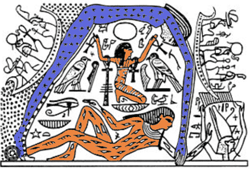
11. Nun
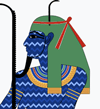
Nut God

13. Nefertiti

>Top <O>:

- ?
<O>:
- [Q1:ir-A40] >Osiris, God of fertility, afterlife, the dead. resurrection; image color is deep green or black =fertile soil
- Black (kemet) means the name of Egypt (Upper Egypt + Lower Egypt =Taui)
- [?] >Ouroboros
1. Osiris God:
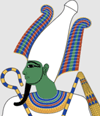
1. Osiris, Anubis, Horus
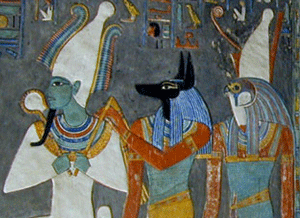
>Top <P>:









<P>:
- [S5-S6] >Pschent, Double Crown of Upper & Lower Egypt
- [<-p:t-wA-l:M-i*i-s->] >Ptolmys Dynasty
- [m] Preposition: -in, with, from, as
- [r] Preposition: -at, towards (place)
- [H-n:a] Preposition: -with
- [n] Preposition: -for, towards (people)
- [i-n] Preposition: -by
- [pr:Z1] per=house, 家
- [a:t-pr] at=room, 部屋
<P>:
>Top <Q>:


<Q>:
- [q:l-A&V4-p:d:r-A&&&(t:H8)] or
[<-q:l-i-wA-p:d:r-G4-t:H8->]
>Cleopatra
<Q>:
>Top <R>:






<R>:
- [r:a-ra:Z1-C2]/r:a-N5 >太陽神; Amen(Amun)-Raアメン神と習合(syncretism)してアメン=ラー
- [i-mn:n-C12] >Amun-Ra =G. Zeus: King of the Gods; God of fertility and life.
- [ra:Z1] > 表意文字であることの決定符・限定詞(determinative);表意文字=semiogram=類別詞=classifier
- [<-ra-ms-s-sw-w->] Ramessess Ⅱ、建築王、長寿、高身長
- [r:k-H-w-Q7-Z3] rekehu=flame, 炎
- [r:m-w-b] remu=fish, 魚
3. Nefertari & Ra
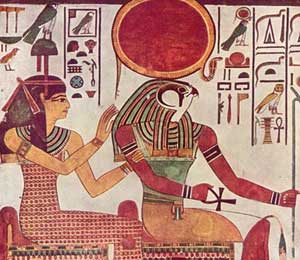
3. Ra
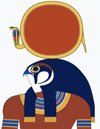
>Top <S>:







 or
or 

<S>:
- [L1] >Scarab Beetle; symbol of death, rebirth, great power, guide & protect in the afterlife; popular amulet; sometimes decorated as winged scarabs, etc.
- [S-H6-w]; š-šw-w: 天空の神Nutを支える大気のShu男神でNutとGeb (大地の神)の父親。
- [s-b-k-I4] >sebek >Sebek神、ワニ神
- [sn-n:t-B1:Z2] sisters; Z2 means plural
- [Sa-A-m-Q7] sham, 熱い、燃える
- [s-wr:r-i-mw-A2] suri=drink, 飲む
- [w-b-n:ra-r:a-ra-m-p*t:pt] shine+sun+in+sky →The sun is shiningin the sky
- [sDm] sedjem, hear
- [spAt] sepat, province
4. Shu男神: Embodiment of wind or air
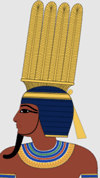
5. Sobek: Crocodile God
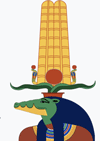
>Top <T>:






<T>:
- [i-mn:n-t-w-t-anx] >Tutan(e)khamen 少年王; 新王国18王朝のファラオ、アクエンアテンの息子。; honorific transpositionの原則でアメン神が最初に記述; アメン神の生ける似姿の意
- [tp:Z1]/D1:Z1 >tp /tep/頭; 〜の上で
- [G26A-t:Z4-A40] >Thoth-God ibis-headed; God of science (astronomy, mathematics, geometry, medicine, botany, theology, etc.) =G. Hermes
- [TA-w-P5] tjaw =wind, 息
- [tp:1] tep =head →beginning
- [tr] ter =season
3. Tutankhamen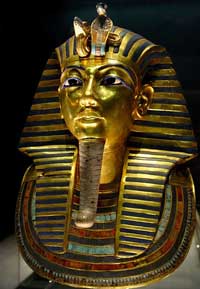
Thoths

>Top <U>:




<U>:
- [I12-I13] >Uraeus (=rearing cobra, uraei (pl)); uraeus on basket; symbol of sovereignty, royalty, deity
- [O16-O17] >uraeus on buildings
- [R9*R9*R9] >3 god flag with cobra at each one base of flag
- [w-b-d:t-Z5-Q7] ubedet >燃える
<U>:
>Top <V>:
<V>:
<V>:
>Top <W>:








<W>:
- [wDAt] Wedjat, Eye of Horus
- [S40\] > 'Was' Scepter; symbol of power, king's prosperity; a staight shaft with shape of a strange animal
- [H5\-N6-H5] >Winged Sun, also known as Behdety used in a temple to represent God; Behediti, the god of the midday sun.
- [M13-i*i-t-I12] > Wadjet (=cobra), Lower Egyptian goddess; Egyptian vulture symbolized Upper Egyptian goddess Nekhbet.
- [G16-nbty] vulture & cobra; Wadjet & Nekhbet
- [wn:n-m-As] wenem =eat
- [wA-A-t:N31] wat=road, 道 =[M31:(t*Z1)]

- [W-b-n:nw*W-Aa2] webenu=injury 傷
Wadjet
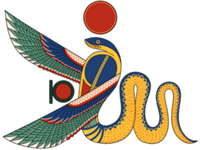
Nekhbet
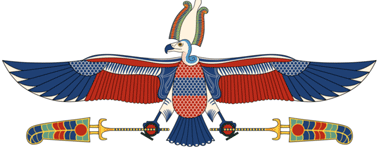
>Top <X>:

<X>:
- [x*t:nb-nfr] het-nebet-neferet =all beautiful things
<X>:
>Top <Y>:

<Y>:
- [y]/Z4 <y2
<Y>:`
>Top <Z>:


<Z>:
- [z]/O34 <z-doorbolt
- [z:t-B1] >zet, set, woman
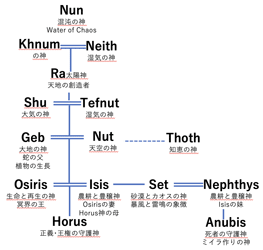
- Ra: the Sun, creator deity
- Thoth: ibis-headed God of knowledge
- Anubis: Tomb caretaker
- Khunum: God of inundation (flood)
- Seth: God of storms
- Min: God of reproductin, with erected penis
- Hathor: daughter of Ra; Solar deity, Goddess of love & music
- Maat: Goddess of truth & justice
- Amun (Amen): hidden God, married to Mut
- Menthu: God of war & strengh
- Ptha: God of craft, creator deity
Gardiner's Sign
Variation
- y
Hieroglyph
Sentence Examble
Remarks

¶-----shine----|-the Sun-|-in--|the sky. ; or the sun is rising in the sky.
- aesthetic arrangement;
- Phonograph: represents sound.;
Verbs come first.
- Ideograms: represents concept & meaning.
eg: the sun with a stroke.
- Determinative: clarifying the meaning.
Index
Comment
- The ancient Egyptian hieroglyphs could not be said as a very structured or efficient method as a writing system of a language. However, it it a fact that the writing system has been used for more than 3,000 years, and now we can recognize vividly the meanings even in 21st century. The system could have been surely superior as a means of recording and communication of then primary language of the super state.
- The inscriptions on hard rocks have contributed to reserve the message engraved on many religious buildings and messages in tombs. It is marvelous that modern people can vividly feel and read the religious passions about the records in this life and imagination in afterlife, thanks to the decipherment by J.F. Champollion, etc.
- Above all, written and designed characters are beautiful, impressive and breathtaking. It is incredible for us to be presently able to understand and feel the meanings as a kind of ’cultural regeneration'.
- Why couldn't we notice such an attraction of Egyptian hieroglyphs as similar users of Kanji characters invented in China about 3000 years ago.
- 古エジプトのヒエログリフの言語としての表記法は、構造的でもなく、効率的とはとても言えない。しかし3000年以上も使用されてきた事実からすれば、当時の超大国の主要言語として、記録と連絡の手段として格段に優れていたからこそその文字が現代にまで伝わっている。
- 宗教施設の碑文、多くの墳墓の記録が、石などに刻印されたこともこのヒエログリフの永続性に寄与した。短い言葉で、現世と来世を表現する宗教的情熱の内容も表現も生き生きと感じられる。
- そして文字が何よりも絵やデザインとして美しく印象的で息を飲むようである。この文字が解読され、言語として再び理解できることは”文化の復活”そのものである。
- 同様に、三千年前の漢字を今でも活用している漢字文化圏に属する我々は、なぜもっと早く、このヒエログリフの魅力に気づかなかったのだろうか。
Ancient Egyptial Hieroglyph
|
Cat: LAN |
|
Sou Miyakawa (宮川創), Jiro Kondoh (近藤二郎), JSesh Software, et al. |
23530u |
Index |
a------A----b----d-----D----g-----h---H--i---k-----K-----l---m---M-----n--o-O-p--q--r--s--S----t----T----w--W--x-----X---y--z |
|||||||||||||||||||||||||||
|---|---|---|---|---|---|---|---|---|---|---|---|---|---|---|---|---|---|---|---|---|---|---|---|---|---|---|---|---|
god |
; ; Amun; Aten; Anubis; Isis; Khonsu; Nut; Osiris; Sebek; Thoth; Uraeus=Cobra god; | |||||||||||||||||||||||||||
Index2 |
; ankh; box=hen; cobra=iart; ear=mesedjer; eat=wenem; eye=iret; fish=remu; flame=akheet; fly=afef; forehead=dehenet; gods=netjer; goose=geb; grape=irep; head=tep; hear=sedjem; Hejet; heka-magic; hen=box; heru=sun; horn=ab; house=per; injury=webenu; make=iri; magic=heka; moon=iaf; ox=neg; papyrus roll=medjat; road=wat; room=at; sail=nai;see=degi; ship=depet; storm=djaw; sweat-fedet; think about=neka; Wadjet; water=mw; Wedjet; wind=tjaw; woman=zet=set; | |||||||||||||||||||||||||||
Re: |
|
|||||||||||||||||||||||||||
Gods |
; Aten; Amen (Amun); Anubis; Four sons of Horus; Geb; Horus; Isis; Khonsu; Nun; Nut; Osiris; Ra; Shu; Thoths; | |||||||||||||||||||||||||||
>Top <Hieroglyph>
|
ヒエログリフ
|
>Top <Tutankhamun>:
|
||
|
||
Various information of Ancient Egypt:
|
古代エジプトいろいろ:
|
Chronology:
|
歴史区分
|
 |
|
|
|
Hieroglyph |
Pronunciation |
Remarks |
|
>Top <A>:
|
<A>:
|
|
Horus |
AmenhetepⅣ |
Anubis
|
||
>Top <B>: |
<B>:
|
<B>: |
>Top <C>: |
<C>:
|
|
>Top <D>: |
<D>:
|
<D>:
|
>Top <E>: |
<E>: Egyptian Math
|
<E>:
|
>Top <F>: |
<F>:
|
<F>: |
>Top <G>: |
<G>:
|
<G>:
|
>Top <H>: |
<H>:
|
Hatshepstu:
|
>Top < I >: |
< I >:
|
Amen (Amun): Creator God, patron deity of Thebes. |
Isis God, |
>Top <J>: |
<J>: |
<J>: |
>Top <K>: |
<K>:
|
Khonsu: Moon God
|
>Top <L>: |
<L>:
|
<L>: |
>Top <M>:
|
<M>:
|
Maat God |
>Top <N>:
|
<N>:
|
4. Nut: Sky Goddess
|
|
11. Nun
|
Nut God |
||
13. Nefertiti |
|||
>Top <O>:
|
<O>:
|
1. Osiris God: |
1. Osiris, Anubis, Horus
|
>Top <P>: |
<P>:
|
<P>: |
>Top <Q>: |
<Q>:
|
<Q>: |
>Top <R>: |
<R>:
|
3. Nefertari & Ra
|
3. Ra
|
>Top <S>:
|
<S>:
|
4. Shu男神: Embodiment of wind or air
|
5. Sobek: Crocodile God
|
>Top <T>: |
<T>:
|
3. Tutankhamen |
Thoths |
>Top <U>: |
<U>:
|
<U>:
|
>Top <V>: |
<V>: |
<V>: |
>Top <W>: |
<W>:
|
Wadjet
|
Nekhbet |
>Top <X>: |
<X>:
|
<X>:
|
>Top <Y>: |
<Y>:
|
<Y>:` |
>Top <Z>: |
<Z>:
|
|
Gardiner's Sign |
Variation |
|
Hieroglyph |
Sentence Examble |
Remarks |
|
|
|
Index |
||||||||||||||||||||||||||||
|---|---|---|---|---|---|---|---|---|---|---|---|---|---|---|---|---|---|---|---|---|---|---|---|---|---|---|---|---|
Comment |
|
|
||||||||||||||||||||||||||